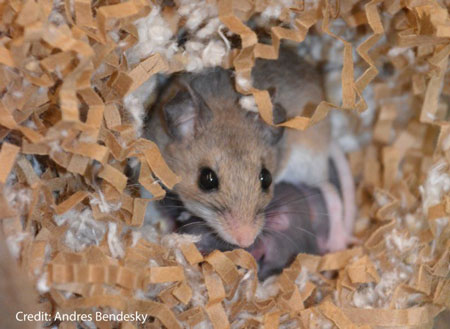We took up the challenge of characterizing the mechanisms underlying the evolution of parental care and chose a system particularly well suited to study this question. Two species of Peromyscus mice, which are as closely related to each other as humans are to Neanderthals, have diametrically opposite mating systems: the oldfield mouse (P. polionotus) is monogamous and the deermouse (P. maniculatus) is promiscuous. However, given their evolutionary proximity, these species can hybridize, providing us with the opportunity to find the genetic differences that explain why they behave so differently.
First, we found that as predicted by their monogamy, P. polionotus fathers show much higher levels of paternal care than promiscuous P. maniculatus fathers. In fact, their parental behavior is nearly as high as that of the monogamous mothers. Interestingly, both monogamous fathers and mothers are in many respects more parental than promiscuous mothers, particularly in the extent to which they build a nest for their pups.

Monogamous animals may be more parental than promiscuous animals because of the intense care they received as young or due to intrinsic genetic differences. To tease apart these possibilities we let parents raise pups of the other species and then tested the parental behavior of the cross-fostered pups once they became parents themselves. We found that parental behavior resembled that of biological parents and not foster parents, consistent with parental behavior being largely heritable in these species.
Having found these large and heritable differences in parental behavior between monogamous and promiscuous mice we then sought the genetic basis of these behavioral differences. We generated hybrids between the two species and tested the parental behavior of these hybrids. By correlating their behavior to the chromosomal regions they inherited from each species we identified 12 regions of their genomes that affect parental behavior. Remarkably, eight of the twelve regions have different effects in mothers and fathers, indicating that even though monogamous fathers and mothers have similar levels of parental care, the genetic trajectories by which they evolved high parental behavior was different in the two sexes.
Some of the genetic regions we identified affect multiple aspects of parental care – like grooming pups, huddling with them and picking them up – while others are more specific. One of these specific regions modulates nest building in both sexes but it does not affect other aspects of parental care. Then, we wanted to know which gene in this region is responsible for the modulation of nest building. Since behavior can evolve through changes in protein sequences or of the levels at which genes are expressed, we looked for these types of changes in genes present in the chromosomal region that affect nest building. We focused on genes expressed in the hypothalamus because this brain area is an important regulator of nest-building behavior. The results pointed to a particularly promising gene known to modulate parental behavior in other rodents, the neuropeptide vasopressin. It was expressed three times higher in the hypothalamus of promiscuous mice (which build poorer nests) than in monogamous mice, suggesting that vasopressin inhibits nest building. To test whether vasopressin, indeed, suppresses nest building we injected vasopressin into the brains of monogamous parents. Remarkably, vasopressin administration mirrored the effect of the genetic region encompassing the vasopressin gene: it decreased nest building in both fathers and mothers but it left other aspects of parental care unaffected. To confirm the inhibitory effect of vasopressin on nest building we turned to laboratory Mus musculus mice, where we had access to more sophisticated tools to manipulate the activity of neurons that release vasopressin. Consistent with the pharmacological results in the monogamous oldfield mice, activating the vasopressin neurons in Mus decreased nest building while inhibiting these neurons increased nest building.
In summary, we characterized the genetic mechanisms by which parental behavior evolves, finding that some genes affect the behavior of fathers and others the behavior of mothers; that some genes affect parental behavior broadly and other genes are specific to individual components of parental care. One of these genes specifically affects nest building and likely corresponds to vasopressin, a neuropeptide that appeared early in animal evolution and that has multiple effects on social behaviors. Our results identify a new role for vasopressin: the inhibition of nest building.
Thanks to the support of HFSP, I have been working to establish Peromyscus as a strong emerging model organism and contributed to the development of bioinformatics resources for this new model system. For example, in this collaborative project, the expertise and resources I developed were essential to narrow down the list of candidate genes for nesting behavior and identify the causal gene.
Reference
The genetic basis of parental care evolution in monogamous mice. Bendesky A, Kwon YM, Lassance JM, Lewarch CL, Yao S, Peterson BK, He MX, Dulac C, Hoekstra HE. Nature 544 (7651): 434-439.
Nature's News and Views feature


































